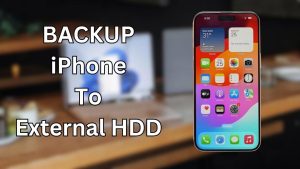In the age of technology, where our lives are inextricably linked to smartphones, the necessity of protecting our valuable data cannot be stressed. It may be devastating to lose important papers, contacts, or images. That’s when the backup, the device longevity superhero, comes into play! In this lesson, we’ll go over how to protect your iPhone’s data.
Importance of Back Up iPhone Data
Consider your iPhone to be a treasure box containing memories, papers, and maybe a collection of humorous cat videos. Consider what would happen if the chest vanished into the digital void. Without a backup, it’s like playing digital roulette, a dangerous game with unfavourable chances. Accidents, malfunctions, or a cheeky kid who enjoys probing buttons may flip your life upside down. However, with frequent backups, you gain control of your digital destiny, ready to confront any unexpected events with a confident smile.
Benefits of Using an External Hard Drive for Backups
Now, let’s speak about the unsung hero of our iPhone backup story: the external hard drive. Why bind yourself to the unpredictable cloud when you may have a dependable, tangible companion? External hard drives provide a concrete stronghold for your digital assets. They provide plenty of capacity, quicker transfer rates, and the satisfying experience of holding your data in your hands (technically, in a sleek compact drive). It’s similar to having a vault for your digital secrets, protected by an impenetrable wall of ones and zeros. So saddle up as we take you on the thrilling journey of backing up your iPhone to an external hard drive – your ticket to data immortality!
Choosing the Right External Hard Drive
Choosing the best external hard drive for iPhone backups is similar to picking the best sidekick for your digital superhero adventures. You want a dependable friend that knows your demands while also complementing your style. Let’s go out to find the best backup ally!
- Compatibility with iPhone: First and foremost, your external hard drive should be compatible with your iPhone. It’s like making sure everyone at the superhero conference speaks the same tech language. Must check for compatibility to avoid unpleasant scenarios like your external drive becoming quiet during critical backup chats.
- Sufficient Storage Capacity: Consider your external hard drive to be a spacious treasure chest, ready to store your iPhone’s valuable memories and data. Make sure it’s big enough to fit not only your existing hoard, but also future purchases. After all, a superhero’s collection of cat memes and selfies is sure to increase.
- Speed and Transfer Capabilities: In the fast-paced world of digital heroics, every second is crucial. Your external hard disc should be the backup universe’s Flash, with lightning-fast performance and flawless transfer capabilities. Nobody likes to go through a tiresome backup procedure when there are more fascinating experiences to pursue.
In the larger scheme of iPhone backups, the ideal external hard drive serves as your partner, confidant, and digital BFF. Choose wisely, and let the backup crusade begin!
Preparing External Hard Drive for Backup
Before going on the heroic adventure of preserving your iPhone’s treasured memories, make sure your trusted companion, the external hard drive, is adequately equipped for the voyage. Consider it like preparing your trusty steed for an exciting expedition – with fewer dragons and more data.
-
Formatting the External Hard Drive:
Consider your external hard drive to be a blank canvas waiting to be painted with the masterpiece of your iPhone backup. Begin by formatting it, which is similar to applying a fresh layer of primer to your canvas before beginning the artistic process. This guarantees that your iPhone and external hard drive are compatible and connect seamlessly. Consider it a handshake between two superheroes before they team together to rescue the day.
-
Creating a Dedicated Backup Folder:
Now that your external hard drive is ready to go, it’s important to set up a unique location for your iPhone backup. Consider this folder to be the VIP area of a high-end club, designated solely for the best – in this instance, your precious data. Creating a specific backup folder not only provides organisation, but also makes it easier to discover your data in the digital jungle.
- Checking for Available Space on the External Drive:
Every hero need a lair large enough to contain their armament, and your external hard drive is no exception. Before you start the backup procedure, evaluate the available space on your drive. This step guarantees that your external hard drive is up to the task, avoiding any unexpected “storage full” barriers in your quest to save your iPhone’s memories.
With your external hard drive now dressed in backup war armour, your iPhone is one step closer to becoming an impenetrable fortress of data resiliency.
Updating iOS and iTunes
In the ever-changing world of technology, keeping your iPhone and iTunes software up to date is critical for a smooth and safe backup. So, let us go on a hunt for the most recent and best upgrades, guaranteeing that our gadgets are at the pinnacle of their digital capabilities.
-
Ensuring iPhone is running the latest iOS version:
First and foremost, let’s give your iPhone a digital spa day. Go to your device’s settings, then ‘General,’ and then ‘Software Update.’ If a brand new iOS version is ready for you, tap the ‘Download and Install’ button. This guarantees that your iPhone has the most recent features, bug fixes, and security upgrades, keeping it a happy and healthy partner on your backup excursions.
-
Updating iTunes on your computer:
Now, let’s pay some love to your computer’s unsung hero, iTunes. Launch iTunes and check for updates as if you were looking for the latest and greatest version. On a Mac, this is available in the App Store; on Windows, it is located within the iTunes menu. Click ‘Check for Updates’ and let the magic happen.
Updating iTunes is like to giving your computer a backstage pass to the iPhone’s show. It assures that they speak the same language, avoiding any communication failures during the backup performance. Plus, who doesn’t enjoy a software update? It’s similar to a digital makeover, but for your computer.
So there you have it: a well-updated iPhone and iTunes, ready to dance in unison when the backup spotlight comes on. Remember that in the tech industry, being current is not simply a fad; it is a must.
Connecting iPhone to Computer
Connecting your iPhone to your computer is an essential step in the exciting adventure of protecting your valuable data. Grab your USB cord with the zeal of a detective unravelling a web of riddles, because we’re about to start on a backup expedition!
-
Using a USB Cable:
The USB cable is a reliable acquaintance in the world of gadgets. It’s more than simply a cable; it’s the link between your iPhone and the safe refuge of data protection, your PC. Gently insert one end into your iPhone and the other into your computer’s USB port. Ah, the beautiful symphony of connection begins.
-
Authorizing the Computer if Required:
Consider this: your computer represents the VIP section, and your iPhone requires a golden ticket to access. If your computer requires authorization (a courteous request in the computing world), simply unlock your iPhone and, if prompted, select “Trust This Computer.” It’s similar to offering entrance to a secret club, but far less mysterious and far more practical.
Remember, this stage is similar to a digital handshake between your devices. It’s a nod of affirmation that says, “Yes, we’re all on the same page, ready to face the challenges of data backup together.”
So there you have it: the USB cable, the unsung hero, and the authorization procedure, your VIP entrance to the elite club of data security. Now, while you sit back and watch the electrical gears spin, take comfort in knowing that your data is on the verge of being embraced by a secure external hard drive. The USB cord has served its purpose, and your iPhone is one step closer to data immortality.
Launching iTunes
Now comes the fun part: starting iTunes and creating the groundwork for a smooth connection between your iPhone and PC. Take a time to locate the familiar iTunes symbol on your computer – you know, the one that has been patiently waiting for its day in the limelight. Click to start the digital symphony.
-
Opening iTunes on the Computer
As you navigate iTunes, imagine it as a backstage ticket to your iPhone’s virtual environment. The classic chords of the iTunes jingle may be playing in your mind while the programme starts up. It’s like inviting a maestro to the stage, ready to lead the backing orchestra.
Pro Tip: If you’ve misplaced your iTunes icon, don’t be concerned; it’s not playing hide and seek. A short search on your computer should reveal it, ready to get to work.
-
Verifying the Connection between iPhone and iTunes
Now it’s time for a virtual handshake to ensure your iPhone and iTunes are on the same page. Use your trusty USB cord to connect your iPhone to the PC. Listen for the tiny notification sound, which confirms that your gadgets are shaking hands in digital fellowship.
Check the iTunes interface for a visible indication that your iPhone has been recognised. It may be a jubilant pop-up or a subtle icon change; in either case, your link is the foundation of this backup procedure.
Remember: If the connection seems hesitant, try a different USB port or cable. Even technology need a gentle shove to initiate the discussion.
So, there you have it: iTunes is open, your iPhone is connected, and the scene is set. The backup fiesta is about to begin, ensuring that your data is safely stored on an external hard drive. Now for the next act!
Initiating Backup Process
Starting the backup process is the critical moment when your iPhone’s digital existence receives a VIP pass to the safety club, and we’re here to help you through it with a splash of humour and professionalism.
-
Selecting iPhone in iTunes:
First and foremost, launch iTunes on your computer, which serves as a backstage ticket to your iPhone’s greatest hits. Once inside, find your iPhone among the simulated sea of gadgets. It’s similar to locating Waldo, but with fewer stripes and more high-tech vibes.
-
Choosing the backup location as the external hard drive:
Consider your external hard drive to be the superhero’s lair for iPhone data. Select it as a safe refuge for your images, contacts, and embarrassing dancing videos. It’s similar like picking a vacation place for your digital memories, but with less sunshine and more ones and zeros.
-
Configuring backup settings (e.g., encrypting backups):
Now let’s add some secret agent flair. Encrypting your backups is like assigning your data a top-secret mission. Set a password, and your iPhone data will be as safe as a vault in an espionage thriller. Just don’t forget the password, or your data may disappear in a way that even Houdini would envy.
Remember, this method guarantees that your iPhone is more than simply a gadget; it is a well-protected digital fortress. So, go ahead and begin that backup with the confidence of a tech-savvy secret agent; you now have control over your iPhone’s fate!
Starting the Backup
In the thrilling world of iPhone data protection, the moment of truth comes when you click the “Backup Now” button in iTunes. You, like a captain piloting a ship across digital waters, seize the helm and set sail on a mission to protect your treasured memories and critical information.
- Clicking on the “Backup Now” button in iTunes:
Now, channel your inner commander and get to iTunes. Locate your iPhone in the sea of devices and confidently hover over the “Backup Now” button. This is your starting point for data protection, your defence against the unpredictability of unintentional deletions and gadget malfunctions. A single click here initiates a symphony of data synchronisation, guaranteeing that each photo, contact, and app is safely stored.
-
Monitoring the progress of the backup:
As the digital gears begin to work, don’t just twiddle your fingers; engage in some data voyeurism. iTunes helpfully includes a progress metre, allowing you to see the metamorphosis of bytes into a protected cocoon. You could find yourself on the edge of your seat, marvelling at the efficiency of contemporary technology or contemplating the secrets of the digital realm.
Remember, this isn’t just a backup; it’s a mini-drama, a moment of tension in which you, dear user, play the role and ensure a happy conclusion for your digital assets. Professionalism meets humour as you track progress with the gravity of a corporate executive overseeing a major project, but don’t forget to enjoy the show. After all, in the world of 1s and 0s, a little levity may make the procedure not only safe but also enjoyable.
Safely Disconnecting iPhone
Now that your iPhone’s valuable data has been securely backed up on your beloved external hard drive, it’s time to say goodbye, but not without a gracious farewell. Safely disconnecting your iPhone guarantees a seamless parting free of emotional baggage (or lost files). Here’s how to say goodbye to your smartphone with style.
-
Ejecting iPhone from iTunes
Assume iTunes is the host of a posh party, and your iPhone is the VIP visitor. Before leaving, your VIP need proper acknowledgement, which is where “Eject” comes into play. Navigate to iTunes, find your iPhone in the device list, and search for the small eject button next to its name. Click it with the finesse of a maestro finishing a symphony, alerting iTunes that your iPhone is ready to take its final bow. This phase eliminates any remaining links and enables a stress-free exit.
-
Safely Unplugging the USB Cable
Unplugging may appear to be a simple chore, but it is actually the final dance move in this sophisticated backup tango. Gently separate the USB cable from both the PC and your iPhone, using your best superhero finesse. Consider it like taking a sword from its sheath: fast, slick, and with a touch of delicacy. This not only eliminates potential cable injuries, but also assures that your iPhone survives the incident intact.
As you say goodbye to your iPhone, pause to admire the symphony of successfully backed-up data. This habit, while seemingly banal, is the foundation of your digital security. So, eject, disconnect, and rest certain that your iPhone is ready for its next adventure – maybe a sequel, thanks to the next backup session!
Testing the Backup
Now that you’ve completed the backup dance by pirouetting your iPhone’s data onto an external hard drive, it’s important to ensure that your performance was faultless. Testing the backup is like the grand finale; it’s the point that distinguishes backup virtuosos from one-hit wonders.
-
Accessing the Backup Folder on the External Hard Drive
Consider the external hard drive to be the VIP lounge for your iPhone’s backstage passes. Connect your external hard drive and go to its folder, which is normally labelled with a date or a name that says, “I’m where your digital memories are stashed.” It’s like unlocking the secret compartment in a magician’s hat, but your data is about to make a magical return.
-
Verifying the Integrity of the Backup Files
Now, let’s play detective to confirm that every bit and byte made it securely to the backup ball. Check your images; are they all there, smiling and posing appropriately? Are your contacts waving at you from the address book? Perform a quick search of your programmes to ensure they did not decide to play hide-and-seek throughout the backup process. A successfully validated backup is equivalent to a standing ovation; it merits acknowledgment and admiration.
Remember that a backup is only as effective as its restoration. So, before you start on your next digital adventure or iPhone update, take a time to appreciate the benefits of a well-executed backup. Your data deserves a round of applause, and you’ve just given it a front-row seat in the security of your external hard drive – the VIP club for everything crucial.
Automating Backups
In today’s fast-paced digital world, backing up your iPhone is critical, but it doesn’t have to be a pain. Enter the amazing world of automation, where your iPhone backups literally happen on their own – all owing to the delights of iTunes.
Setting up automatic backups in iTunes is like to having your own personal backup genie. Simply launch iTunes on your computer, connect your iPhone using the dependable USB connection, and pick your device from the upper left corner of the screen. Now, go to the “Summary” page and choose the option “Automatically sync when this iPhone is connected.” Voila! Your iPhone and iTunes have now been synced and are ready to dance anytime they meet.
But wait—there’s more! We’re not stopping at just any sync; we’re delving into the world of scheduling. Configuring scheduled backup schedules guarantees that your data is preserved on a regular basis, without you lifting a finger. In the “Summary” page, click the “Options” button to see the secret to a stress-free life: “Sync with this iPhone over Wi-Fi.” When you choose this option, your iPhone and iTunes will be able to do wireless backups.
Consider this: while you’re drinking your morning coffee or debating the finest cat memes, your iPhone is quietly backing up its valuable data to an external hard drive. It’s like having a personal assistant who recognises the worth of your recollections and critical information.
Automating backups protects your data while also adding a touch of futuristic beauty to your digital life. So, set it and leave it, and let iTunes work its magic while your iPhone and external hard drive seamlessly complete the backup waltz. Your data deserves nothing less than a backup ballet in the digital era!


